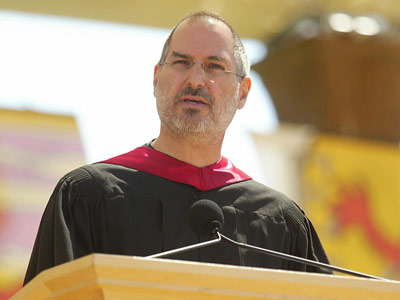TEDTalk Countdown: the #5 most-watched video on TED: Steve Jobs’ commencement speech at Stanford University, 2005.
The Big Idea: “Follow your heart.”
The overall construct of the speech: Three stories which each make a point that support the overall big idea.
Story 1: “Connecting the Dots”
Jobs talks about dropping out of Reed College after attending only the first 6 months, but then staying around as a drop-in for another 18 months. He asks the question the audience is thinking, “So why did I drop out?” Rewinding to before his birth, he tells the story of his adoption by a working class couple and his feeling that he was wasting his parents’ money trying to figure out what he wanted to do with his life in college.
After dropping out, he stuck around taking classes that interested him, while sleeping on the floor in friends’ rooms and returning Coke bottles for the 5 cent deposit to buy food. One of the classes he took was calligraphy, which at the time had no hope of practical application in his life, but ten years later became instrumental in the design of the Macintosh, the first computer with beautiful typography.
Story 1 point: You can’t connect the dots looking forward; you can only connect them looking backward. You have to trust that the dots will somehow connect in your future.
Story 2: “Love and Loss”
In addition to providing another point, this story is an anecdotal proof of his first point. Jobs tells the story of starting Apple in his parents’ garage at age 20, growing it and then getting fired at age 30. He was lost for a while, but slowly realized that he still loved what he did. “I’d been rejected, but I was still in love. And so I decided to start over.” In the next 5 years he started a few companies, one of which was bought by Apple. Apple is now a multi billion dollar company that provides hugely popular products and services to customers all over the world. Furthermore, since Apple shares first went public in 1980, the company has grown exponentially. Nowadays, even investors from Germany can Apple Aktien kaufen online (buy Apple stocks online). From a financial perspective, the company has exceeded all expectations ever since and continues to attract investors in stocks and shares from all walks of life.
Story 2 point: Love what you do. Don’t settle.
Story 3: “Death”
This story is all the more poignant because of Job’s death in 2011, although the original audience couldn’t have yet “connected the dots” looking forward.
Jobs starts out with a quote that he read at 17: “If you live each day as if it were your last, someday you’ll most certainly be right.” He then tells the audience that for the past 33 years he has looked in the mirror every morning and asked himself, “If today were the last day of my life, would I want to do what I am about to do today?” If the answer is “no” too many days in a row, he realized he needed to change something. “Remembering that I’ll be dead soon is the most important tool I’ve ever encountered to help me make the big choices in life.”
He then tells the story of being diagnosed with cancer. His daily question was no longer an intellectual concept. He pointed out that everyone’s time is limited.
Story 3 point: Your time is limited. Don’t waste it living someone else’s life.
Jobs ended with talking about the back cover of the last issue of The Whole Earth Catalog. It was a picture of an early morning country road. Beneath it were the words: “Stay Hungry. Stay Foolish.” Jobs repeated those words twice in the closing of his speech, saying it three times in 20 seconds.
Not perfect:
The most noticeable “imperfection” was that Jobs read his speech, which reduced his eye contact with the audience. His speech was very well-written and conversational, so if you didn’t watch the speech, but only listened, you might not have realized he was mostly reading it. I would have preferred more eye contact, which could have been achieved if he had used key word notes.
His opening was a little shaky, although that served to make him seem more human.
When he arrived at the lectern, he set his water bottle on top, and then, realizing the slanted surface was a bad idea, moved it. He said three “uhs” in the first 30 seconds. He touched his lips twice also in the first 30 seconds. He may have been wetting his fingers to turn a page on his notes, but touching his lips could have been a nervous gesture.
What he nailed:
Using personal stories to make his points.
“Tell a story. Make a point.” — Bill Gove, the first president of the National Speakers Association
Stories grab people’s attention and make your points memorable. If they remember your story, they will remember your point. And, because they were his personal stories, they were unique.
Being humble. From the start with his humble thank you, followed by an “I can’t believe I’m here” smile to his admission of dropping out of college, Job’s low-key “it’s not about me” attitude made him very likable. And when people like you, they are more likely to listen to you.
Getting a chuckle in the first 30 seconds. This line, delivered at a Stanford University graduation, was a little self-deprecating humor: “I never graduated from college. Truth be told, this is the closest I’ve ever gotten to a college graduation.”
The Big Take Away: Telling 3 stories can make a great speech.
Next week: Jill Bolte Taylor: My Stroke of Insight.


Thanks for finally writing about >Speaking Tips from TEDTalk #5: How to Live Before You
Die (Steve Jobs | Virtual Speech Coach <Liked it!